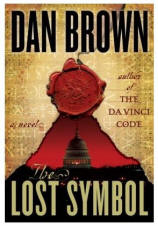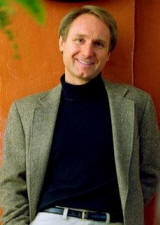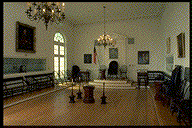The Lost Symbol
Dan Brown
According to booksellers, this was 2009's most anticipated novel. And why not? After a somewhat lackluster writing career with three books not getting too very far, Dan Brown somehow tapped into the world's psyche with his The DaVinci Code. This work was true to pre-release reports which said it was going to feature Freemasonry and Washington, DC.
In the wake of The DaVinci Code, a whole cottage industry sprang up with books attempting to explain the facts behind the fiction of Brown's novel, this may be quite different. While there are twists and turns galore, the anticipated 'clarifying' books fall a bit flat since Mr. Brown has done a very good job in the various plot devices he employed. Books like the excellent Solomon's Builders by Freemason Chris Hodapp written well in advance in anticipation were, we see now in retrospect, certainly excellent for Masonic information but lacking in addressing the key features of the actual book.
 We'd
written just before the book was released:
We'd
written just before the book was released:
"Surely Albert Pike will become part of the mix and we suspect that the foolishness of David Ovason's "Secret Architecture" will come into play too. There may also be the usual goo-goo, gaa-gaa over the Scottish Rite 33rd Degree as being somehow a 'big deal' (see our page 33rds Rule) as well as some things about 'Rebel Gold' and the Knights of the Golden Circle. At least that's where some of the pre-release clues have pointed."
And while the 33rd Degree of the Scottish Rite (not specifically stated as such) played a big part in the book, it sure wasn't the way 99.9% of the Masonic community assumed. Yep, it's that old word ASSUMED again. There had been a lawsuit by two Masons, Michael Baigent and Richard Leigh of The Holy Blood and The Holy Grail, who claimed that Mr. Brown had used "a substantial part of the work to produce an altered copy or a colourable imitation" in creating The DaVinci Code. While their book was universally panned by scholars as bunk, it was a tedious and expensive lawsuit in which Mr. Brown finally won with the ability to recover some $6 million dollars knowing he'd probably never see a penny. This too pointed towards a potential (and understandable) antagonism towards Freemasons. (You can read pieces from the court decision here.)
Finally, knowing that Mr. Brown lived in a community which is home for an outspoken anti-Masonic author, Steven Tsoukalas, we were even more concerned than most. Those concerns, though, soon dissipated as the 'Harvard Symbologist' character shows his students, at the beginning of the story, how silly internet rants of the conspiracy obsessed really are. We believe that if Mr. Tsoukalas were to read this book, he'd be incensed since everything he rails about in Masonic Rites and Wrongs, the story's main character makes clear is both good and right - and, in fact, somewhat responsible for saving society from the dark forces of evil embodied in those who choose to demand a blind adherence to what they define as religion. (This time we'll likely hear a lot of spurious charges from Masonophobes about Mr. Brown being 'in league' with the Masons or some such foolishness....)
While some have whined that the climax came well before the book's end and others have fixated over the ceremony with which the book begins (something taken from an exposure of a competing and no longer existent Scottish Rite group called the Cerneau Scottish Rite that existed in the late 1800s primarily in New York - and yes, there is such a thing as 'Fake Masonry' alive and well both then and now and which you can read more about here), we'd suggest that despite the quibbles and clarifications, this was a pretty good read. We know a LOT of folks who're against Freemasonry are going to be awfully unhappy that the evil CIA and the awful Masons weren't seen as anything but trying to 'do the right thing' but they really should 'get a life'!
Interviews right after publication found a few Catholics whining bitterly about their mistreatment compared to that of the horrid Freemasons and a far less-than-successful author came across looking as shrill as the rest. In addition, those who hoped that they'd be able to hang on to Mr. Brown's coat tails have found themselves looking pretty stupid, as the authors of Rebel Gold have found. Only a cameo appearance involving Albert Pike and then only while rushing by his bust in a stairway and reading the inspirational engraving there? Shucks!
Want to follow up more?
Remembering this is a book of fiction, one should not read more into it than a good 'thriller' including all the requisite high-tech stuff of today's fiction. However, a visit around a Masonic lodge room will reveal things that have been incorporated into the plot line. Look! Over on that picture on the wall. There's the.... No, I'd just ruin it for you!
But here: the Dan Brown's web page is a visual treat. Providing a lot of the detail behind the Masonic stuff discussed in the book is Mason Mark E. Koltko-Rivera, Ph.D. whose blog Key to The Lost Symbol Clues has kept a lot of us entranced in the months leading up to the publication date. Although Mark had found a publisher for a planned book, this really isn't at all like The DaVinci Code from the point of view of 'hanging plot questions' and Mark's publisher - like several others - may 'pull the plug' on it. Too bad as there's a lot to learn from these things....
 From a Masonic standpoint, it's mildly
comical that after a decade of hand wringing over declining membership including
'one day classes' touted by some as the solution to that problem, we now
see a great many people approaching our doors having 'heard about' Freemasonry
from Dan Brown novels or the internet - and then finding that a favorite uncle
or grandfather was a member. They want the 'full experience' - and indeed it is
a great one.
From a Masonic standpoint, it's mildly
comical that after a decade of hand wringing over declining membership including
'one day classes' touted by some as the solution to that problem, we now
see a great many people approaching our doors having 'heard about' Freemasonry
from Dan Brown novels or the internet - and then finding that a favorite uncle
or grandfather was a member. They want the 'full experience' - and indeed it is
a great one.
Further, we believe that there's a vast reservoir of good will that exists toward Freemasonry - and Dan Brown has certainly exuded a pretty fair amount of it in this book. In fact, we tweeted early the next day that this book was indeed a "love letter to Freemasonry", a phrase that others copied early on.
We're not going into the plot line or the many twists and turns of the story here but if you're a Mason and don't read this book, you're missing a great opportunity to learn more about your organization than you might imagine. If you're an American, it should make you proud.
If you're anti-Masonic you're going to just HATE this book - so I hope you'll get it too! If you're a religious intolerant, you'll be muttering about the damn Deists and the mixing of religions that occurs in Masonic lodges. I can see some of the Masonophobes displayed on this site plugging their ears and shutting their eyes: they just will HATE this book. But I liked it - and I hope you will too.
And by the way: if you're just curious and don't have anything better to do some night next week, joining Freemasonry is NOT for you. If, on the other hand, you are really moved somewhere deep inside by the things 'Symbologist Robert Langdon' said, you might want to look at our page about Masonic membership here.
![]()
The Marketing Code by Stephen Brown
This book is, we think, really quite a good read, particularly for someone who might be involved in marketing in ANY way - and this includes you there, Freemasons, thinking about how to build up lodge membership! Written in the style of Dan Brown's The Davinci Code by an author who jokes about shamelessly benefiting from the similarity (without relation) of author names, the work has a VERY unique plot twist: masonicinfo.com is mentioned in the story. Here's the excerpt:
"Gelli was a Freemason."
"The poster-boy of Freemasonry by the sound of him."
"He was expelled from the Freemasons because his organization was tarnishing their good name. It was his expulsion that brought down the whole P2 edifice down and with it the government of Arnaldo Forlani." King Billy had finally settled on a website, and sat back to let Magill look. "The full story's here on masonicinfo.com. The Freemasons are the best source on Gelli because of the damage he did and is still doing to them."
Gosh! And just so you know, the page that King Billy was reading was, in fact, real. It's right here. "The full story...." Yep, that's what we try to provide on this site - and even fictional characters recognize it!
(I won't mention that whenever someone can't remember my name, they always call me 'Bill' or 'Billy' - or that I bought a medical billing computer system from a salesman named Stephen Brown several years ago. That would make this all just TOO spooky!)
![]()
![]()





